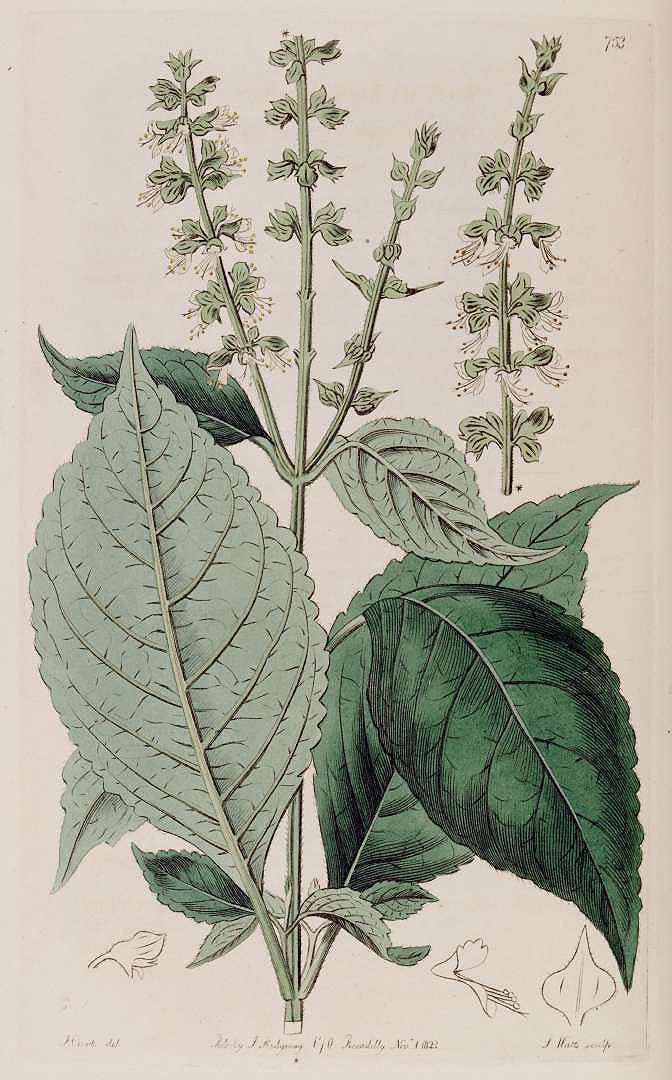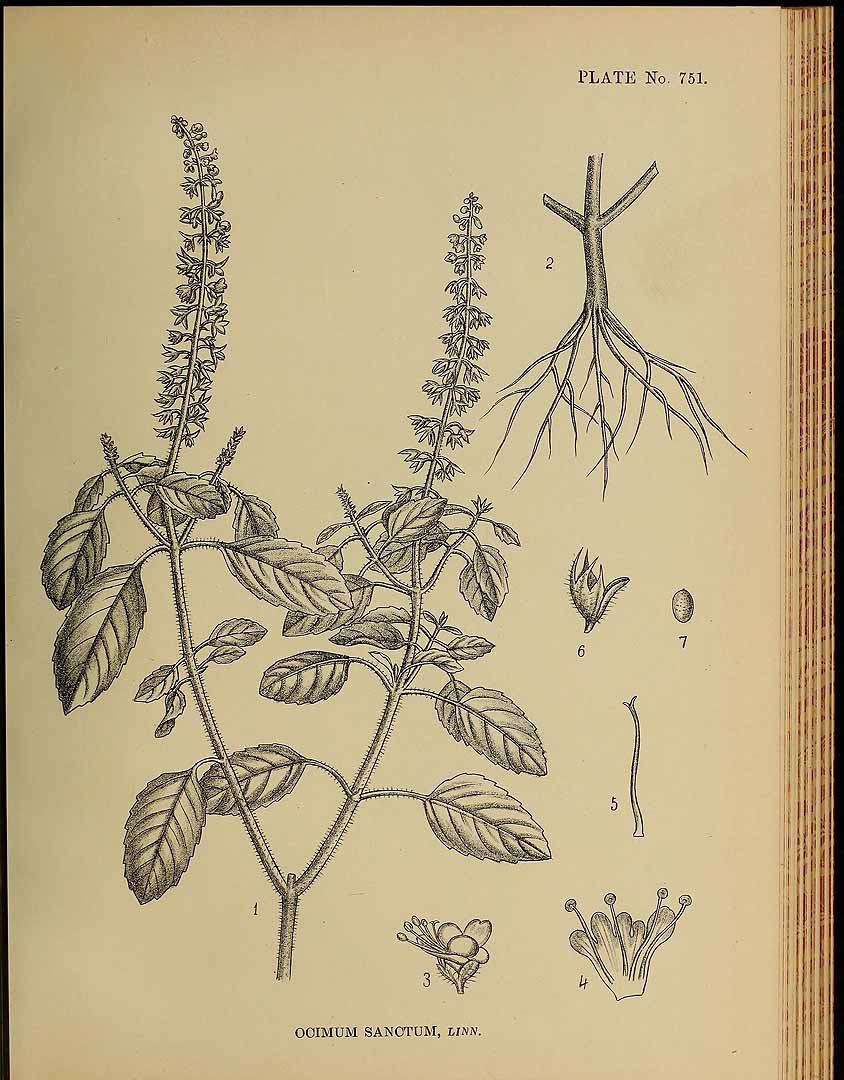
TULSI- The Queen of Herbs
HOLY BASIL
Holy Basil is an herbaceous plant in the mint family (Lamiaceae) that is native to South Asia. It grows throughout lowland regions of India, Sri Lanka, Pakistan, Bangladesh, southern China, Thailand, and Malaysia (Winston and Maimes, 2007). In its native range, holy basil is a perennial; however, it is not frost-tolerant and thus is annual is more temperate climates. It likes rich, moist soil, sun or partial shade, and will willingly spread if given the space to do so. The species name, sanctum, reflects the sacred nature of the plant in Indian culture. In India, holy basil is considered sacred to the Hindu god Vishnu, who considered basil the incarnation of the Goddess herself. In Sanksrit, tulasi means “that which is incomparable”, and in Hindi this word is tulsi, hence its common names. Tulsi is commonly grown in special pots in the courtyards of Hindu homes.


Holy basil has three varieties: O. sanctum (synonym O. tenuiflorum) includes holy basil rama, which has green leaves, and
holy basil Krishna, which has dark green to purple leaves and a stronger taste and smell;
O. gratissimum includes holy basil vana, a wild variety with green leaves (Winston and Maimes, 2007).
Of course holy basil is in the same genus as the common garden basil (O. basilicum) that Westerners are very familiar with.
The word holy in the name of their basil varieties reflects this herb’s sacred place in Indian culture for millennia and its revered use as a spiritual symbol, ritual offering, and household medicine.
This shrubby plant grows to a height of 3 feet. It contains green and purple leaves, arranged in opposite pairs on a slightly hairy stem. The small white/purple flowers are arranged tightly in a long raceme.
The flowers bloom starting in mid-summer and are loved by bees.
The leaves and flowering tops are harvested and used fresh or dried for use in teas, tinctures, or infused oils. The active constituents in holy basil include flavonoids, triterpenes, ursolic acid, volatile oils, mucilage, and vitamins A and C (Winston and Maimes, 2007; Wood, 2008).
Energetically, holy basil is warming/cooling with a, pungent taste. Holy basil is indicated for cold, congested, stuck conditions due to the stimulating effects of its volatile oils. As a nervine, it is initially stimulating, but then brings a calm and reassuring sense of being grounded which in turn helps quiet active thought patterns within the mind, collect distracted thoughts into focus, and give one a sense of resilience for the long haul. It is uplifting and joyful, guiding open the heart to feel gratitude and a yearning for emotional connection.
Holy basil has antibacterial, antifungal, antiviral, adaptogenic, immunomodulating, antioxidant, neuroprotective, radioprotective, anti-cancer, alterative, antispasmodic, expectorant, decongestant, carminative, stimulating, emmenagogue, galactagogue, nervine, heart opening, and antidepressant actions.
Like many plants in the mint family, holy basil works to open and balance, particularly in the head, the heart, and the stomach.
Its expectorant, decongestant, stimulant, emmenagogic, and galactagogic actions are opening, while its alterative, immunomodulating, carminative, antidepressant, and nervine actions are balancing.
In Ayurveda, holy basil is considered a rasayana herb, one that “nourishes a person’s growth to perfect health and promotes long life” (WInston and Maimes, 2007). In Western herbalism, holy basil is considered an adaptogen, helping the body respond in a measured way to stressors, thus reducing the negative effects of stress on physical and emotional health and providing balance. Holy basil’s antioxidant, neuroprotective, and radio-protective actions are considered protective and anti-aging (Winston and Maimes, 2007). The languaging may be different between the two traditions, but the tonic, health-supporting effect of holy basil is the same.
Holy basil has a long history of use for the respiratory ailments due to its antiviral, antibacterial, decongestant, and diaphoretic actions (Wood, 2008).
It is useful in the treatment of colds and flu, due to its ability to move congestion, stimulate circulation and perspiration to reduce fever, and kill microorganisms.
In India, holy basil is also used as an expectorant tea for bronchial mucus (Winston and Maimes, 2007) due to its ability to warm and clear stuck congestion. As a tonic, it also shows beneficial actions for asthma and allergies.
Holy basil is an immunomodulator, strengthening and balancing the immune system’s ability to respond to infection.
Holy basil is considered to be helpful in the prevention and treatment of cancer. Preclinical studies have shown that holy basil “prevented chemical-induced skin, liver, oral, and lung cancers”; and was shown to “mediate these effects by increasing the antioxidant activity, altering the gene expressions, inducing apoptosis, and inhibiting angiogenesis and metastasis.” (Baliga et al., 2013). Baliga et al. (2013) also review studies which indicate that holy basil protects against radiation-induced sickness, mortality, skin tissue damage, and DNA damage due to its phytochemicals (flavonoids, orintin, vicenin, eugenol, rosmarinic acid, apigenin, and/or carnosic acid).
Holy basil’s ability to stimulate appetite and digestion, move stagnant food, and relieve flatulence (Wood, 2008) also helps decongest the digestive system, as well.
In Ayurveda, holy basil is used to alleviate indigestion, gastric distress, and vomiting (Winston and Maimes, 2007). Like so many of the mint family plants, holy basil’s volatile oils produce warming, antispasmodic, and carminative actions to help to soothe the digestive system.
Holy basil is also used to regulate blood sugar in people with diabetes. (Agrawal et al., 1996).
As an alterative, holy basil “removes heat and toxins from bloodstream, liver, circulation, and intestines” (Wood, 2008). Holy basil can also support detoxification of toxins stored in body fat such as metals, medical drugs, and compounds from marijuana use; in India and the Middle East, holy basil has long been used for this latter purpose (Wood, 2008).
As a nervine, holy basil has a dual action as it is both stimulating and relaxing to the brain. While these are seemingly disparate effects, they are indeed related. Holy basil has been used to regulate the nervous system by its opening action, moving blocked energy to dispel sluggishness as well as move and direct restless energy to ease hyperactivity and inability to concentrate (Altman, 2014). Other herbalists have commandeered holy basil to treat poor memory, attention deficit disorder (ADD), and attention deficit hyperactivity disorder (ADHD) because of its ability to enhance cerebral circulation; and to treat stagnant, situational depression, in which one is stuck in a depressive state related to a particular trauma (Winston and Maimes, 2007).
By moving stuck energy in the energetic nervous system, holy basil ‘lifts’ the symptoms of depression, uplifting the heart and allowing it to open to feel emotion and connection with others. Holy basil also helps heart health by enhancing healthy circulation via its slight blood thinning and circulatory stimulant actions, reducing cardiovascular stress both physically and via its adaptogenic actions.
Holy basil also has anxiolytic action, helping in the case of anxiety. In a clinical study of generalized anxiety disorder (GAD) with 35 patients, participants were given 500 mg of holy basil plant extract (O. sanctum) twice a day after meals. The study observations indicated that holy basil “significantly (p<0.001) attenuated generalized anxiety disorders and also attenuated its correlated stress and depression” (Bhattacharyya et al., 2008).
Due to its stimulating, warming action, holy basil gently promotes menstruation in women suffering from amenorrhea, while its antispasmodic action soothes menstrual cramping and pain (Wood, 2008, Altman, 2014). It is also used as a galactagogue to stimulate milk production in nursing women.
In ancient Indian texts, holy basil is described as a treatment for snake bites and scorpion stings; Indian folk medicine employs a poultice of holy basil roots and leaves for insect bites and stings (Winston and Maimes, 2007).
Adaptogen Antibacterial Anticancer Alterative Antifungal Antioxidant Antispasmodic Carminative Antidepressant Emmenagogue Expectorant Galactogogue Immunomodulant Nervine Radioprotective Tonic Stimulant Anxiolytic
Queen of Herbs Tea Blend
(both tea and elixir are available in shop)
Holy basil is known as the queen of herbs for it’s remarkable ability to find the area of the body that is under the most stress and harmonize the senses. this apoptogenic blend with assist with pain while providing balance and harmony to your entire system
2 parts holy basil Rama
1 part St. John’s wort
1 part Lotus stamen
1/2 part white willow bark
Place 1-2 Tablespoons in 8 ounces hot water. Steep for 15 minutes then remove tea bag or receptacle. Sweeten if desired.
Holy Basil Elixir
Fill 8 ounce glass jar 1/2 way with dried Holy Basil Rama
Cover completely with Brandy of your choice covering the herbs by 1 inch at top
Top off jar with Local organic honey
Place in cool dry place for 4-6 weeks, shaking vigorously every day.
At the end of the 6 weeks strain with cheesecloth into large bowl making sure to squeeze as much of the liquid from the herbs.
Compost the herbs and place the leftover liquid into a glass bottle with dropper
Directions: take 5-60 drops 3 times daily under tongue or diluted with liquid.

